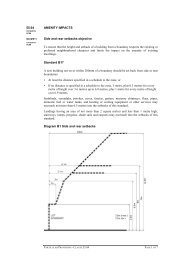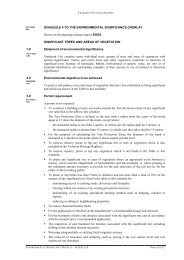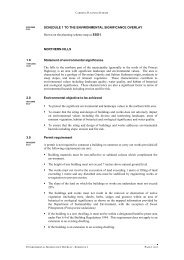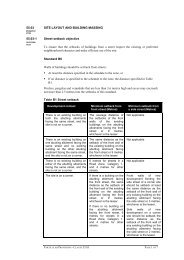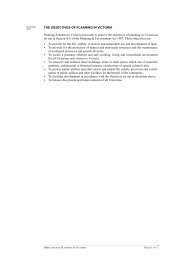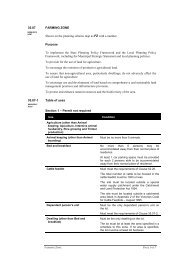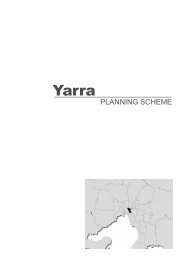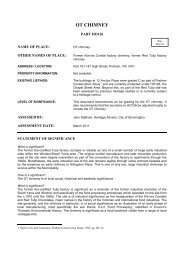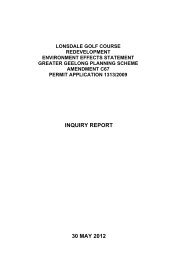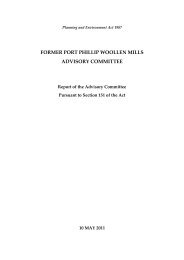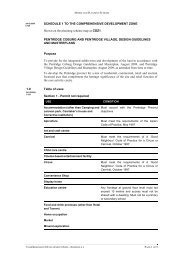environmental significance overlay - schedule 1 - Victoria's Planning ...
environmental significance overlay - schedule 1 - Victoria's Planning ...
environmental significance overlay - schedule 1 - Victoria's Planning ...
You also want an ePaper? Increase the reach of your titles
YUMPU automatically turns print PDFs into web optimized ePapers that Google loves.
23/09/2011<br />
VC77<br />
BANYULE PLANNING SCHEME<br />
SCHEDULE 1 TO THE ENVIRONMENTAL SIGNIFICANCE OVERLAY<br />
Shown on the planning scheme map as ESO1.<br />
YARRA RIVER, PLENTY RIVER AND DAREBIN CREEK<br />
1.0 Statement of <strong>environmental</strong> <strong>significance</strong><br />
19/01/2006<br />
VC37<br />
These areas stretch along the Yarra River, Plenty River and the Darebin Creek and have<br />
significant natural habitat and <strong>environmental</strong> qualities. Recent studies have included these<br />
areas in sites of State and Regional faunal <strong>significance</strong> and High and Medium habitat<br />
<strong>significance</strong>. They include predominantly streamside areas supporting open space and<br />
substantial remnants of indigenous vegetation and wetlands of at least local conservation<br />
<strong>significance</strong>, which in turn, provide habitat for a variety of native animals threatened with<br />
local extinction. Vegetation and wetlands are also recognised as major contributors to the<br />
landscape quality and visual amenity of the area.<br />
The significant fauna that occurs in or utilizes this area includes the vulnerable Swift Parrot<br />
and rare species including the Eastern Broad-nosed Bat, Large-footed Myotis, Baillon’s<br />
Crake, Australasian Bittern, Little Bittern, Lewin’s Rail, Latham’s Snipe, Black Falcon,<br />
Grey Goshawk and Powerful Owl. There are also numerous regionally significant species.<br />
The continued viability of these areas and their resident species as a significant<br />
<strong>environmental</strong> resource is under threat from the continued development of open space,<br />
weed invasion and feral animals, and the disturbance arising from humans and their<br />
companion animals. The remaining areas of native vegetation have become increasingly<br />
fragmented and their habitat value is threatened. Accordingly the protection of the native<br />
vegetation and wetlands and the maintenance and enhancement of these habitats for<br />
indigenous fauna are of vital importance.<br />
2.0 Environmental objective to be achieved<br />
19/01/2006<br />
VC37<br />
To protect areas along watercourses from development and loss of vegetation that may<br />
damage the streamside environment as a visual, conservation, ecological and recreation<br />
resource.<br />
To enhance and encourage the conservation and maintenance of the streamside<br />
environment as a conservation, ecological and recreation resource.<br />
To address the threatening processes associated with widespread habitat loss and<br />
degradation that has occurred in North East Melbourne.<br />
To conserve water quality and watercourse capacity to enable appropriate beneficial<br />
land use and water-based activities to be undertaken.<br />
To encourage the retention and enhancement of a continuous corridor of indigenous<br />
vegetation along river and creek banks in order to provide corridors for the movement<br />
of wildlife.<br />
To protect the watercourse and adjoining parkland and its flora and fauna from the<br />
effects of polluted waters conveyed by the stormwater system or other means.<br />
To protect and enhance sites with archaeological or scientific <strong>significance</strong>.<br />
To encourage development consistent with any approved concept plan for the area.<br />
To ensure that development is compatible with the natural <strong>environmental</strong> character and<br />
landscaped qualities of the watercourse and its surrounds.<br />
ENVIRONMENTAL SIGNIFICANCE OVERLAY - SCHEDULE 1 PAGE 1 OF 5
3.0 Permit requirement<br />
19/01/2006<br />
VC37<br />
3.1 Buildings and works<br />
19/01/2006<br />
VC37<br />
3.2 Vegetation<br />
08/10/2009<br />
C61<br />
BANYULE PLANNING SCHEME<br />
A permit is required to construct a fence.<br />
A permit is not required for:<br />
Any building which is to be used for a dwelling unless:<br />
the height of any part of a wall is more than 4.5 metres above the natural surface<br />
level of the ground directly below it; or<br />
any part of the building is more than 6 metres above the natural surface of the<br />
ground directly below that part.<br />
Drainage works undertaken by the responsible authority.<br />
Works undertaken by a public authority to:<br />
lay underground sewerage, water and gas mains, oil pipelines, underground<br />
telephone lines and underground powerlines of less than 220,000 volts if they do not<br />
alter the topography of the land; or<br />
erect telephone or power lines without involving the construction of any towers or<br />
poles;<br />
to construct a road on land reserved for existing or proposed road purposes provided<br />
they are undertaken in accordance with a plan prepared to the satisfaction of the<br />
responsible authority.<br />
Building and works carried out in accordance with a management plan prepared to the<br />
satisfaction of the Responsible Authority.<br />
A permit is required to remove, destroy or lop any vegetation.<br />
This does not apply:<br />
To the removal, destruction or lopping of native vegetation which has been planted for<br />
garden or horticultural purposes and which is less than 5 metres high and has a single<br />
trunk circumference of less than 0.5 metres at a height of 1 metre above ground level.<br />
To the removal, destruction or lopping of exotic vegetation which is less than 5 metres<br />
in height and has a trunk circumference of less than 0.5 metres at a height of 1 metre<br />
above ground level.<br />
To the removal, destruction or lopping of vegetation identified as <strong>environmental</strong> weed<br />
species in Banyule Weed Management Strategy 2006, unless otherwise specified in<br />
Schedule 4 to the Environmental Significance Overlay.<br />
To the removal or pruning of street trees in accordance with the Banyule Street Tree<br />
Strategy.<br />
To the pruning of vegetation to remove any branch which overhangs an existing<br />
dwelling or is within 2 metres of an existing dwelling.<br />
To the pruning of vegetation to maintain or improve its health or appearance.<br />
To the pruning or removal of vegetation to prevent damage to works when damage to a<br />
pipeline, electricity or telephone transmission line, cable or other service has occurred<br />
or is likely to occur.<br />
ENVIRONMENTAL SIGNIFICANCE OVERLAY - SCHEDULE 1 PAGE 2 OF 5
BANYULE PLANNING SCHEME<br />
To the removal, destruction or lopping of dead vegetation, unless the dead vegetation is<br />
a habitat tree containing hollows.<br />
To the pruning, removal or destruction of any vegetation where an agreement exists<br />
between a railway carrier and the Department of Sustainability and Environment, or<br />
where the pruning, removal or destruction of vegetation is the minimum amount<br />
necessary to provide for the safe operation of the rail service for the safety of the<br />
travelling public.<br />
To the removal, destruction or lopping of vegetation carried out in accordance with a<br />
management plan prepared to the satisfaction of the responsible authority.<br />
4.0 Decision guidelines<br />
23/09/2011<br />
VC77<br />
4.1 Buildings, works and subdivision<br />
23/09/2011<br />
VC77<br />
4.2 Vegetation<br />
08/10/2009<br />
C61<br />
Before deciding on an application to construct a building, or to construct or carry out<br />
works, or to subdivide land, or whether a plan is satisfactory, the responsible authority<br />
must consider:<br />
The Middle Yarra River Concept Plan - Dights Falls to Burke Road, August, 1990; the<br />
Middle Yarra Concept Plan - Burke Road to Watsons Creek, July 1991; the Lower<br />
Plenty River Concept Plan, October 1994; the Lower Darebin Creek Concept Plan,<br />
March 1995; or any other approved concept plan, as relevant.<br />
The effect of the development on the natural ecosystems of the area.<br />
The conservation and enhancement of the area.<br />
The need to prevent erosion and pollution.<br />
The existing use and development of the land.<br />
The views of the relevant drainage authority.<br />
The need for all excavation and fill slopes to be of a gradient less than 1 in 5,<br />
revegetated immediately following construction and maintained thereafter by the<br />
applicant.<br />
The benefits of limiting retaining walls to be not more than 1.5 metres above ground<br />
level.<br />
The need for at least 50 percent of a site to be native vegetation, lawn or other pervious<br />
open space. It should not contain a building, swimming pool, pavement or other<br />
impervious surface.<br />
The nature and appropriateness of the means proposed to prevent pollution of<br />
waterways during construction.<br />
The impact of new industries in relation to air pollution and odours.<br />
Whether the location, bulk and appearance of the building or works will be in keeping<br />
with or enhance the visual amenity derived from the natural and landscaped character of<br />
the area.<br />
The need to maintain the natural environment as the dominant visual element of the<br />
area.<br />
Before deciding on an application to remove, destroy or lop any vegetation the responsible<br />
authority must consider:<br />
ENVIRONMENTAL SIGNIFICANCE OVERLAY - SCHEDULE 1 PAGE 3 OF 5
BANYULE PLANNING SCHEME<br />
The role of native vegetation in conserving flora and fauna.<br />
The need to retain native or other vegetation if it is rare, supports rare species of flora or<br />
fauna or forms part of a wildlife corridor.<br />
The need to retain vegetation which prevents or limits adverse effects on ground water<br />
recharge.<br />
The need to retain vegetation:<br />
Where ground slopes exceed 20 percent.<br />
Within 30 metres of a watercourse or wetland.<br />
On land where the soil or subsoil may become unstable if cleared.<br />
On land subject to or which may contribute to soil erosion, slippage or salinisation.<br />
In areas where the removal, destruction or lopping of vegetation could adversely<br />
affect the integrity or long term preservation of an identified site of scientific, nature<br />
conservation or cultural <strong>significance</strong>.<br />
Which is of heritage or cultural <strong>significance</strong>.<br />
Any relevant permit to remove, destroy or lop native vegetation in accordance with a<br />
land management plan or works program.<br />
Whether the application includes a land management plan or works program.<br />
Whether provision is made or is to be made to establish and maintain native vegetation<br />
elsewhere on the land.<br />
The Middle Yarra River Concept Plan - Dights Falls to Burke Road, August, 1990; the<br />
Middle Yarra Concept Plan - Burke Road to Watsons Creek, July 1991; the Lower<br />
Plenty River Concept Plan, October 1994; the Lower Darebin Creek Concept Plan,<br />
March 1995; or any other approved concept plan, as relevant.<br />
Any report on the value or otherwise of the specified vegetation including:<br />
An Inventory of Sites of Environmental Significance in the City of Banyule and<br />
Adjoining Areas, Banyule City Council, September 1995,<br />
Sites of Faunal and Habitat Significance in North East Melbourne, Cam Beardsell,<br />
1997,<br />
Lower Plenty River Concept Plan Vegetation Report 1991,<br />
Banyule Weed Management Strategy 2006, and<br />
Wildlife Corridor Program, Banyule City Council, 2000.<br />
The conservation and enhancement of vegetation in the area.<br />
The benefits of retaining a buffer strip of vegetation within specified distances of<br />
watercourses, roads and property boundaries.<br />
The benefits of requiring planting, replanting or other treatment of any part of the land.<br />
The views of the relevant drainage authority.<br />
Any proposed landscape plan or agreement to replace areas of vegetation on the site.<br />
The management of vegetation to minimise fire hazard and to ensure safety to people<br />
and property.<br />
If appropriate, the views of Parks Victoria, with those views to be sought under Section<br />
52 of the <strong>Planning</strong> and Environment Act 1987.<br />
Whether the native or exotic vegetation makes a significant contribution to the visual<br />
amenity or landscape qualities of the streamside environment.<br />
ENVIRONMENTAL SIGNIFICANCE OVERLAY - SCHEDULE 1 PAGE 4 OF 5
References<br />
BANYULE PLANNING SCHEME<br />
An Inventory of Sites of Environmental Significance in the City of Banyule and Adjoining<br />
Areas, Banyule City Council, September 1995.<br />
Sites of Faunal and Habitat Significance in North East Melbourne, Cam Beardsell, 1997<br />
Wildlife Corridor Program, Banyule City Council, 2000<br />
Banyule Weed Management Strategy 2006<br />
ENVIRONMENTAL SIGNIFICANCE OVERLAY - SCHEDULE 1 PAGE 5 OF 5



